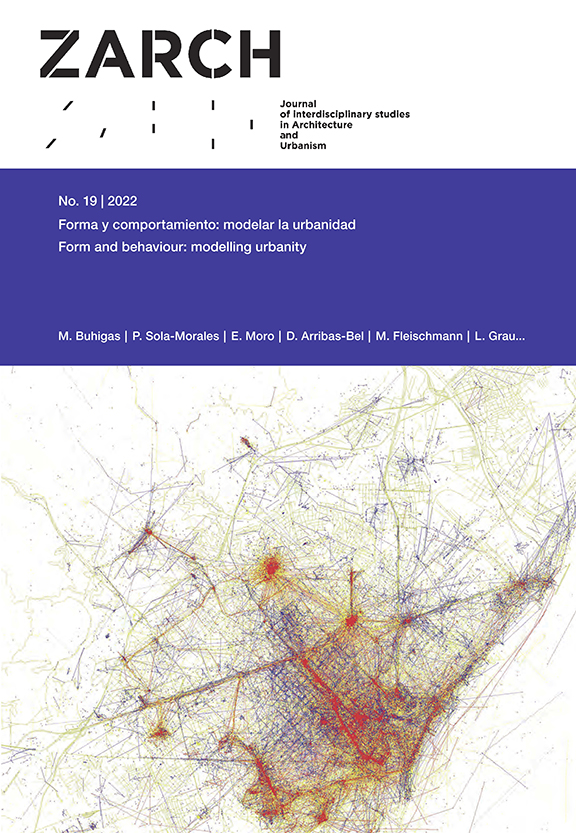An approach to the captive driver in the context of the 15-minute city. The case of Astigarraga
DOI:
https://doi.org/10.26754/ojs_zarch/zarch.2022196925Keywords:
mobility, data visualization, interfaces, captive driver, sustainabilityAbstract
One of the greatest challenges of the contemporary city in the context of energy transformation is that of sustainable mobility, an issue marked by the dichotomy between the city centre and its periphery, among others. This article exposes the case study of a project the authors carried out in their professional practice in RAZ: an analysis of wage labour-related commuting in the municipality of Astigarraga, Gipuzkoa, conducted as part of the municipality's sustainable urban mobility plan. The case study shows the inherent difficulties of contemporary metropolitan mobility dynamics, and helps to draw the profile of the captive driver of the private car. We carried out the analysis using methodologies based on data analysis, visualization or simulation, which illustrate the opportunities that this type of methodologies offers, also in the field of sustainable mobility.
Downloads
References
Atxaga, Bernardo. Astoa eta Euskal Hiria. https://www.atxaga.eus/blog/1241601116 (consultada el 16 de abril de 2022).
Beimborn, Edward; Greenwald, Michael; Jin, Xia. 2003. Accessibility, connectivity, and captivity: impacts on transit choice. Transportation Research Record: Journal of the Transportation Research Board 1835. DOI: 10.3141/1835-01.
Borja, Jordi. 2015. Prólogo: Revolución y contrarevolución en la ciudad global. En Capital financiero, propiedad inmobiliaria y cultura, David Harvey y Neil Smith, 9-29. Barcelona: Universitat Autònoma de Barcelona.
Departamento de Desarrollo Económico e Infraestructuras del Gobierno Vasco, 2016. Estudio de la Movilidad de la Comunidad Autónoma Vasca. Vitoria-Gasteiz: Servicio Central de Publicaciones del Gobierno Vasco.
Departamento de Desarrollo Económico e Infraestructuras del Gobierno Vasco, 2019. Directrices de Ordenación Territorial de la Comunidad Autónoma del País Vasco. Vitoria-Gasteiz: Servicio Central de Publicaciones del Gobierno Vasco.
Garcés, Marina. 2018. Una globalización de barrio. En Ciudad Princesa, 63-7. Barcelona: Galaxia Gutenberg.
Garnier, Marina. 2020. La Ville du ¼ d’heure. Du concept à la mise en oeuvre. Paris: Université Paris 1 Panthéon Sorbonne.
Google. API de Google Transit. https://developers.google.com/transit/gtfs (consultada el 29 de abril de 2022).
Jacques, Cynthia; Manaugh, Kevin; El-Geneidy, Ahmed M. 2013. Rescuing the captive [mode] user: An alternative approach to transport market segmentation. Transportation 40(3): 625-45. DOI: 10.1007/s11116-012-9437-2.
López de Lucio, Ramón. 2017. El ‘Ecobulevar’ del PAU de Vallecas, 1995-2016 Un caso paradigmático de fracaso del planeamiento y el diseño urbanos y de la arquitectura. ZARCH 8: 42–61. DOI: 10.26754/ojs_zarch/zarch.201782163.
Palacio del Elíseo. Interview du Président Emmanuel Macron à la revue Le Grand Continent. Canal de Youtube del Elíseo. https://www.youtube.com/watch?v=GV2ZI8eOd18 (consultada el 18 de abril de 2022).
RAZ. 2021. NORA SmartKalea. Método computacional para el análisis de hábitos de movilidad. La avenida Sancho el Sabio como caso de estudio. Donostia / San Sebastián: Fomento San Sebastián.
Rutherford, Brent y Wekerle, Gerda. 2013. Captive rider, captive labor: Spatial constraints on women's employment. Urban Geography 9: 116-37. DOI: 10.2747/0272-3638.9.2.116.
Van der Maaten, Laurens y Hinton, Geoffrey. 2008. Visualizing Data using t-SNE. Journal of Machine Learning Research 9: 2579-605.
Walker, Jarret. 2011. How Clearer Thinking about Public Transit Can Enrich Our Communities and Our Lives. Washington DC: Island Press.


